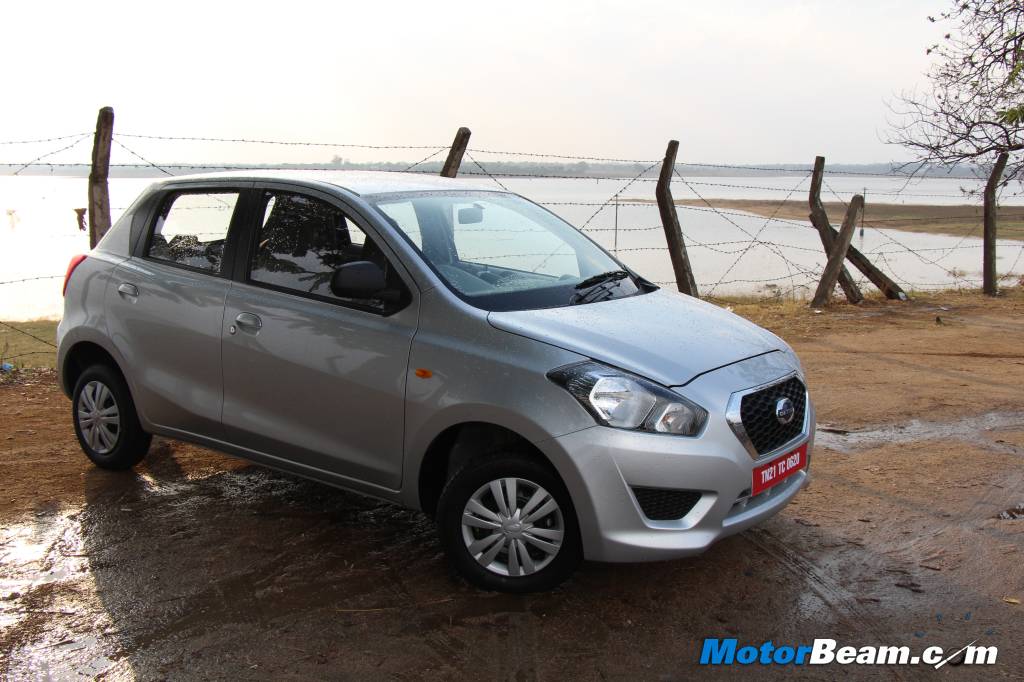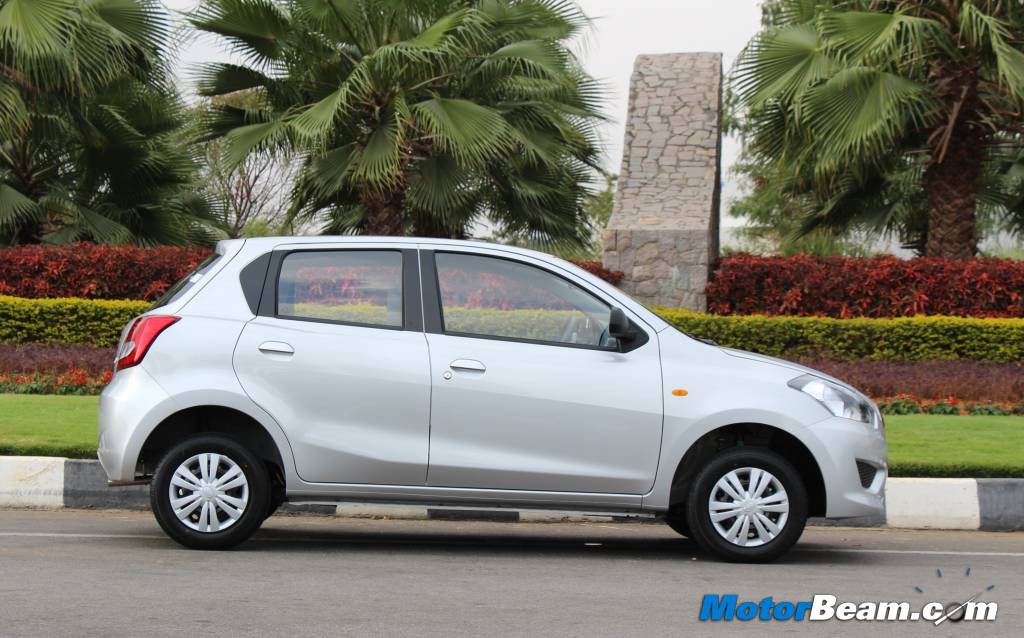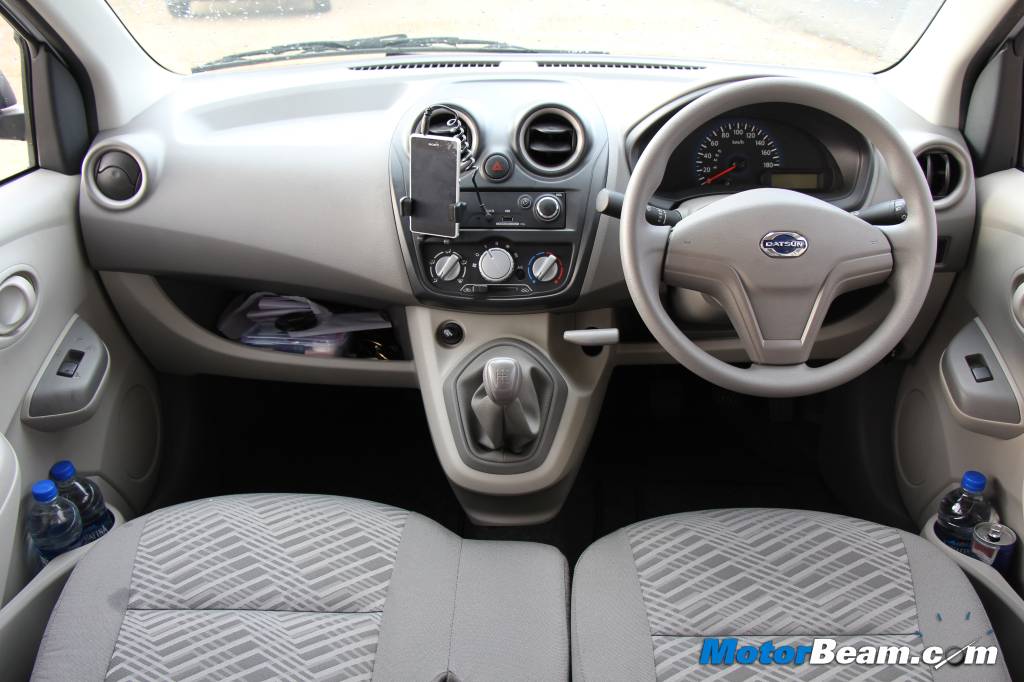
2014 Datsun GO Review
Car Tested: 2014 Datsun GO
Price OTR Mumbai: Rs. 4.39 lakhs
Test Location: Hyderabad
The Datsun GO sets a new benchmark for space and size in its segment.
Nissan is one of the most popular car companies in the world, known for offering well engineered products which rank high on quality and performance. Datsun on the other hand is owned by Nissan since a very long time and had its roots in the USA, where it was extremely popular in the 1980s (as Nissan exported vehicles to the States using the Datsun name, a mistake they regretted later which cost them $800 million ~ Rs. 5000 crores in the 1980s). The resurrection of the Datsun brand is Nissan’s way of targeting the mass market and on the onset, the idea seems bright. While most people might now know this but extensive Nissan bits will go into Datsun cars so you can expect the same good quality and reliability. The Datsun GO is the first product from the new badge (in its second coming) and we take a quick drive to judge if Nissan has got it right.

Small cars need to look cheap and dare we say it, ugly, or that’s what most manufacturers have made us believe. Thankfully, Nissan has other ideas with the Datsun GO, a car which in no way looks cheap or made to a price. In fact, the Datsun GO looks more pricier than what Datsun intends to price it which surely is a good thing. Although based on the Micra’s V-platform, there is absolutely no Micra in the design, instead you get an attractive looking vehicle which is compact in dimensions and boasts of clean lines. The only unattractive part is the single wiper blade as it’s too long and robs the symmetry from the vehicle. The GO is no doubt among the best looking vehicle in its class which is like half the battle won.

Step inside though and cost cutting is evident, that too in abundance. The rear view mirrors have to be adjusted by hand by opening the window (no stalk to operate them) while only the front power windows are offered and the rear ones are manual even on the top-end model (the driver can’t control any window except his own). No variant of the Datsun GO comes with ABS or airbags and there isn’t a rear windshield demister, let alone a rear wiper (the rear windshield doesn’t have rubber beading on the inside and every time someone closes it, the rear seat occupant is going to be rattled to the bone). If that’s not enough of cost cutting, then you shouldn’t miss the boot door which doesn’t have a key-hole, you have to open the boot by getting inside the car, always. Furthermore, the rear seat belt doesn’t have a pull back mechanism so you have to manually adjust the belt for your size.
Nissan has paid careful attention to the dashboard of the Datsun GO. The car gets beige interiors with the top of the dash being finished in a slightly darker shade. The centre console gets an even more darker shade of brown but the colour combination doesn’t look out of sync. Datsun has offered a plethora of storage bins inside the cabin as so evident by the open glovebox and big door pockets but surprisingly the rear doors get no pockets, nor any provision for speakers (there is no parcel shelf either). There is space on the dashboard as well as two small storage bins for the driver, below the right most AC vent, no storage bin is covered, not even the glovebox which lacks a lid.
The instrument cluster appears very basic with a large speedometer (with gear shift indicator guide markings) and a small LCD which digitally displays a tachometer, fuel meter, trip computer and distance to empty along with real time fuel efficiency. Quite a few parts come from the Micra like the AC vents, door handles, indicator and wiper stalks, etc. The gear lever has been mounted on the dashboard while the handbrake is quite quirky and placed below the AC controls, near the steering wheel, it has a push/pull mechanism which scrapes your leg even while driving (even the steering scrapes your left leg, more so if you are tall). The Datsun GO also gets follow-me home headlamps, a segment first feature.
The front seat is a large unit with no space between the two seats, instead there is cushion (as the co-passenger seat is wider). While Nissan isn’t implicitly stating this car can seat six, the fact is the added flexibility can turn out to be a big advantage in semi-urban and rural areas for the Datsun GO (as a small child can fit here). However one must understand that the seat area is too less due to the seat belt harness and the third passenger in the front won’t get a seat belt so the longer bench type seat is useful for keeping stuff only but hampers visibility from the rear. Step in the rear and you will be pleasantly surprised by the amount of interior room. The Datsun GO has space aplenty, something you don’t really find in this segment. Not only can three sit abreast at the rear, they can do so in reasonable comfort.
The seats of the Datsun GO are slim but supportive and headroom is good but under-thigh support is a bit lacking and the integrated headrests on all seats isn’t such a good idea (more so at the rear as rear end collision can cause whiplash injury). The GO gets an integrated 2-speaker audio system which has no display and works with AUX only as radio and CD functions have been skipped, there is a USB charging port and a mobile holder on the unit as well. Quality of the cabin is good with plastics being on the harder side but should be durable as our long term Nissan Micra has shown no signs of wear in spite of some rough usage. The boot of the Datsun GO is easily class leading with 265-litres of storage capacity (even bigger than the Micra) and the rear seat can be folded in one piece to boost practicality further.
Powering the Datsun GO is the de-tuned 1.2-litre, 3-pot motor from the petrol Micra which outputs 68 PS of power at 5000 RPM (the same engine in the Micra makes 76 PS at 6000 RPM) and 104 Nm of torque at 4000 RPM. This engine is relatively smooth for a 3-cylinder mill and the light weight helps it gather good pace quickly. Mid-range is strong and the engine keeps charging, losing steam sharply in the top-end as the rev-limiter cuts in too early at just 5200 RPM. Near the rev limit, the motor is filled with vibrations, buzzing in despair but in spite of the 3-pot configuration, the motor has good NVH throughout the power band with on idle vibes being the major achilles heel. The vibrations are more when the AC is switched off as the engine RPM reduces.
In fact the tuning done on the engine of the Datsun GO is so much better than the Nissan Micra that you really don’t put the 3-cylinder motor in inferior hardware category. In spite of the modest horse power, the GO is quite fast with 0-100 km/hr coming up in 14 seconds, aided by its light weight and good power to weight ratio. Not only can you potter around town in higher gears with comfort, you can also cruise on the highways without the engine feeling uneasy. The 5-speed gearbox has decent shift quality although it feels a bit notchy but the clutch is light. The ARAI claimed mileage for the Datsun GO is 20.6 km/l which is better than the Micra even though it is equipped with the same motor. Expect real world mileage to be around 15 km/l, making the Datsun GO quite frugal.
The Datsun GO is aimed at first time car buyers, whom Nissan likes to call ‘risers’. Comfort is of utmost priority and the first time buyer isn’t going to push the wheels of the vehicle. Thus the suspension has been set up for a pliant ride and the GO does excel when it comes to ride quality although the suspension doesn’t cope that well with really bad roads. Stability at speed is decent but NVH levels are poor (wind noise at speed is close to unbearable) and the lack of sound absorbing material on the wheel wells and doors is a big omission. Handling isn’t the car’s forte but it is the ease with which you can drive that really impresses. Body roll is very evident and that’s largely due to the way this car has been set-up with high profile rubber and loads of suspension travel. The steering is light and devoid of much feel but no car in this segment really gives you a feedback rich unit. To Nissan’s credit, the steering does weigh up decently at speed but the light weight does affect the car on windy roads asking you to drop pace. Brakes have good stopping power but the tyres don’t support the car and the lack of ABS means any hard braking results in the tyres locking up.
Our initial stint with the Datsun GO has impressed us. The car has a lot going for it. While most vehicles in this segment offer a compromised product, Nissan has given first time car buyers a genuinely good alternative although cost cutting is glaringly evident in many places. The GO not only ticks the right boxes when it comes to important criterias like space, comfort, ride quality, efficiency and affordability, it is also appealing and not obnoxiously shaped like some of its rivals. The 2-year/unlimited mileage warranty is just the cherry on the GO (no pun intended) and as ironic as it may sound, the GO’s chief rival has its name in its tagline. Nissan is serious about the Indian market and with its solo journey commenced for sales and service, the Datsun GO is undoubtedly one of the best cars for the first time car buyer.
The Datsun GO is an entry-level car designed carefully to appeal to the first time car buyer and the Japanese automaker has managed to get it right on most fronts.
What’s Cool
* Practical cabin with multiple storage bins
* Interior and boot space
* Pliant ride
What’s Not So Cool
* Cost cutting quite evident in certain areas
* No safety features




